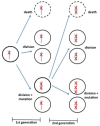Modeling tumor evolutionary dynamics
- PMID: 23420281
- PMCID: PMC3572685
- DOI: 10.3389/fphys.2012.00480
Modeling tumor evolutionary dynamics
Abstract
Tumorigenesis can be seen as an evolutionary process, in which the transformation of a normal cell into a tumor cell involves a number of limiting genetic and epigenetic events, occurring in a series of discrete stages. However, not all mutations in a cell are directly involved in cancer development and it is likely that most of them (passenger mutations) do not contribute in any way to tumorigenesis. Moreover, the process of tumor evolution is punctuated by selection of advantageous (driver) mutations and clonal expansions. Regarding these driver mutations, it is uncertain how many limiting events are required and/or sufficient to promote a tumorigenic process or what are the values associated with the adaptive advantage of different driver mutations. In spite of the availability of high-quality cancer data, several assumptions about the mechanistic process of cancer initiation and development remain largely untested, both mathematically and statistically. Here we review the development of recent mathematical/computational models and discuss their impact in the field of tumor biology.
Keywords: modeling; mutation; somatic mutations; tumor; tumorigenesis.
Figures

Similar articles
-
Cancer heterogeneity: converting a limitation into a source of biologic information.J Transl Med. 2017 Sep 8;15(1):190. doi: 10.1186/s12967-017-1290-9. J Transl Med. 2017. PMID: 28886708 Free PMC article. Review.
-
Cancer initiation with epistatic interactions between driver and passenger mutations.J Theor Biol. 2014 Oct 7;358:52-60. doi: 10.1016/j.jtbi.2014.05.018. Epub 2014 May 20. J Theor Biol. 2014. PMID: 24859427
-
Clonal evolution driven by superdriver mutations.BMC Evol Biol. 2020 Jul 20;20(1):89. doi: 10.1186/s12862-020-01647-y. BMC Evol Biol. 2020. PMID: 32689942 Free PMC article.
-
An Evolutionary Approach for Identifying Driver Mutations in Colorectal Cancer.PLoS Comput Biol. 2015 Sep 17;11(9):e1004350. doi: 10.1371/journal.pcbi.1004350. eCollection 2015 Sep. PLoS Comput Biol. 2015. PMID: 26379039 Free PMC article.
-
Unraveling the Drivers of Tumorigenesis in the Context of Evolution: Theoretical Models and Bioinformatics Tools.J Mol Evol. 2023 Aug;91(4):405-423. doi: 10.1007/s00239-023-10117-0. Epub 2023 May 29. J Mol Evol. 2023. PMID: 37246992 Review.
Cited by
-
Mathematical models for translational and clinical oncology.J Clin Bioinforma. 2013 Nov 7;3(1):23. doi: 10.1186/2043-9113-3-23. J Clin Bioinforma. 2013. PMID: 24195863 Free PMC article.
-
Elucidating the correlations between cancer initiation times and lifetime cancer risks.Sci Rep. 2019 Dec 12;9(1):18940. doi: 10.1038/s41598-019-55300-w. Sci Rep. 2019. PMID: 31831779 Free PMC article.
-
A new model of time scheme for progression of colorectal cancer.BMC Syst Biol. 2014;8 Suppl 3(Suppl 3):S2. doi: 10.1186/1752-0509-8-S3-S2. Epub 2014 Oct 22. BMC Syst Biol. 2014. PMID: 25350788 Free PMC article.
-
Safety of Nivolumab Added to Chemoradiation Therapy Platforms for Intermediate and High-Risk Locoregionally Advanced Head and Neck Squamous Cell Carcinoma: RTOG Foundation 3504.Int J Radiat Oncol Biol Phys. 2023 Mar 15;115(4):847-860. doi: 10.1016/j.ijrobp.2022.10.008. Epub 2022 Oct 11. Int J Radiat Oncol Biol Phys. 2023. PMID: 36228746 Free PMC article.
-
A multiscale model of the role of microenvironmental factors in cell segregation and heterogeneity in breast cancer development.PLoS Comput Biol. 2023 Nov 22;19(11):e1011673. doi: 10.1371/journal.pcbi.1011673. eCollection 2023 Nov. PLoS Comput Biol. 2023. PMID: 37992135 Free PMC article.
References
-
- Armstrong B., Doll R. (1975). Environmental factors and cancer incidence and mortality in different countries, with special reference to dietary practices. Int. J. Cancer 15, 617–631 - PubMed
LinkOut - more resources
Full Text Sources
Other Literature Sources

